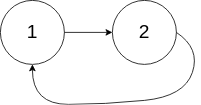Class Solution
- java.lang.Object
-
- g0101_0200.s0142_linked_list_cycle_ii.Solution
-
public class Solution extends Object
142 - Linked List Cycle II.Medium
Given the
headof a linked list, return the node where the cycle begins. If there is no cycle, returnnull.There is a cycle in a linked list if there is some node in the list that can be reached again by continuously following the
nextpointer. Internally,posis used to denote the index of the node that tail’snextpointer is connected to ( 0-indexed ). It is-1if there is no cycle. Note thatposis not passed as a parameter.Do not modify the linked list.
Example 1:

Input: head = [3,2,0,-4], pos = 1
Output: tail connects to node index 1
Explanation: There is a cycle in the linked list, where tail connects to the second node.
Example 2:

Input: head = [1,2], pos = 0
Output: tail connects to node index 0
Explanation: There is a cycle in the linked list, where tail connects to the first node.
Example 3:

Input: head = [1], pos = -1
Output: no cycle
Explanation: There is no cycle in the linked list.
Constraints:
- The number of the nodes in the list is in the range
[0, 104]. -105 <= Node.val <= 105posis-1or a valid index in the linked-list.
Follow up: Can you solve it using
O(1)(i.e. constant) memory? - The number of the nodes in the list is in the range
-
-
Constructor Summary
Constructors Constructor Description Solution()
-